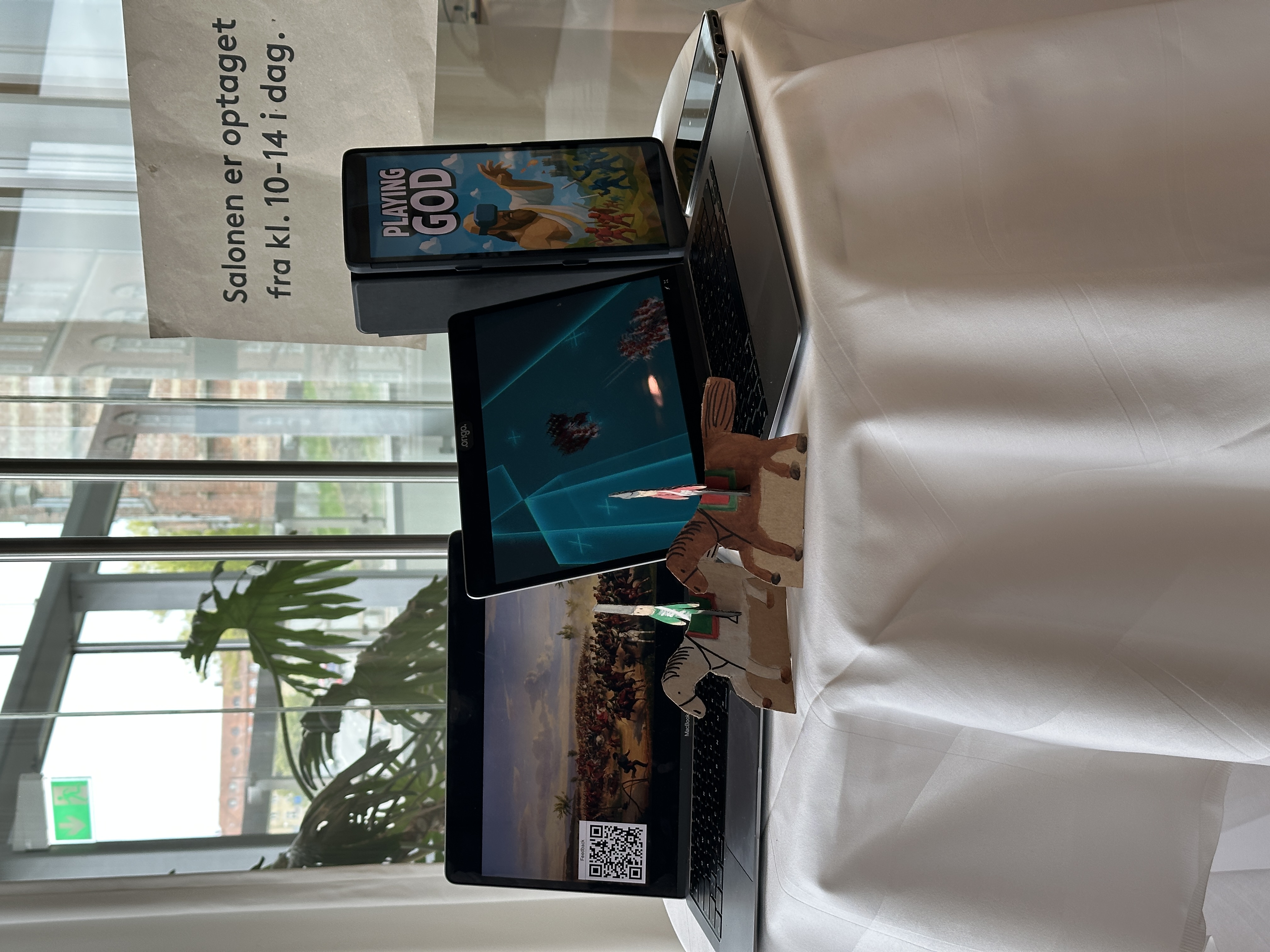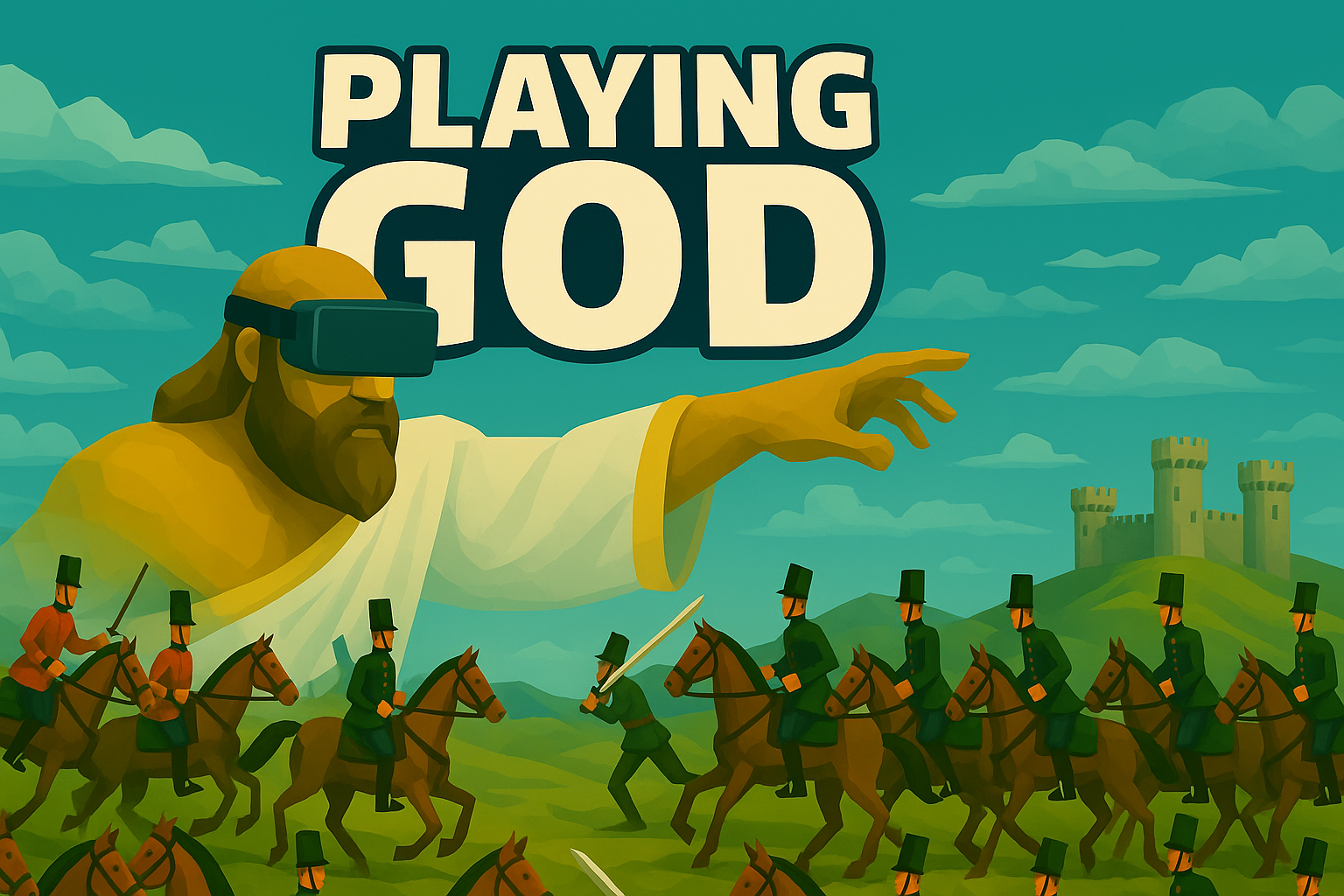Game Log 4 – Create
Game Log 4: Create
Expo Preparation
We found the best way to pitch the game was to create a short promovideo before the Expo, showcasing the most important and fun aspects of the game. This way, we could show a trailer at the Expo, and another screen with the current gameplay. For the expo setup we had a screen with the cultural heritage we were remixing (painting, Rytterkampen ved Aarhus den 31. maj 1849), a screen showing the current view of the person playing the game and our concept art of the game (on the right in the photo), which would play the trailer later into the Expo. We also had small cardboard cutouts of the models used in game, representing the two sides fighting in the painting.

Each new player got a short lesson about the interaction methods using a hand ray, pinch to pick a menu item on the left wrist and to interact with a soldier. After that most people played with little help. We believe the live casting of other people playing and having fun was the biggest positive impact on our booth, although with the current limitations of the Meta Quest it was not a true 1:1 experience since the passthrough was missing in the stream. However, it did help when players less experienced with XR needed guidance.
Technical Description
The build runs in Unity 6 with the Meta Quest SDK and the Mixed Reality Utility Kit. We used the new Behaviour Tree system for soldier AI. All work was done on a Quest 2, but the app should also work on the Quest 3.
The game area is prepped when the game is first started, allowing the player to scan the room they are playing in and modifying different scanned objects to either work as surfaces or obstacles for the game objects. The game then starts in a main menu screen showing a menu to either start or quit the game. The painting we took inspiration from works as the background to show our cultural inspiration and immersing the player. When the player presses the start button the passthrough activates and the room that they have scanned to the device appears with the surfaces and obstacles set. The battleground is populated by a set amount of soldiers, the same amount on both sides and they start fighting according to the combat AI we created, finding the closest target and causing damage to them by attacking. The player can then affect these soldiers by selecting an option from their left wrist menu, which contains the options: move, give weapon and slay, and by ray interaction and pinching select the action and the soldier they want to affect. The game ends when there are no more soldiers on one side of the battle and a win screen is displayed, describing who won and telling a little snippet about war. The game then goes back to main menu.
Our biggest technical hurdle was navigation in an environment that only exists during runtime. The headset mesh started out with no floor collider, so early soldiers would not spawn at all. This was fixed by a MRUK setting, which created the collider and mesh so the navmesh would be baked. First tests were rather slow once more than thirty agents tried to think at once. By changing the times when the knights would look for a target, we could easily run about one hundred agents in the scene.
Art work brought its own tasks. We edited low-poly soldier+horse models to resemble the painting, painted new textures, and made simple animations because free horse animations were very hard to find, and trying to apply a human walking on all fours animation to a horse model had... bad results.
Feedback & Interpretation
Roughly fifteen people played during the Expo and five filled in the questionnare that playtesters could answer after testing the game. We also spoke with every player right after they removed the headset. The first section was about general information and background and had typical questions such as age and gender but also questions about previous experience with VR or AR, experience with hand gestures and experience with sandbox/battlegrounds games. Most people had some experience in all of these fields.
The second part of the questionnaire was about the gameplay. Both the game concept and the gameplay were rated 3.83 stars out of 5. People thought the cultural aspect was clear and had no difficulties getting used to the game mechanics. Most people also agreed that the AR was executed quite successfully.
The third part of the questionnaire was about what kind of feelings the game evoked during playing. People seemed to enjoy the game and felt powerful during gameplay.

Short talks after each round echoed those notes. The main trouble they reported was the wrist menu. The buttons felt small, and because every mode also moved a pinched soldier, players would be unsure of their effects. If we were to move forward with the game, addressing these issues would be our top priority, making sure the controls are intuitive and do what you expect with no side effects. We believe the game is quite scalable, and could go in many directions such as a story mode or involving more wars.
Get Playing God
Playing God
A simulated battleground AR game where you get to decide which side wins by playing god.
| Status | Prototype |
| Author | arteamidk |
| Genre | Simulation |
| Tags | Augmented Reality |
More posts
- Game Log 3 – Imagine36 days ago
- Game Log 2 – Play59 days ago
- Game Log 1 – Experience73 days ago


Leave a comment
Log in with itch.io to leave a comment.